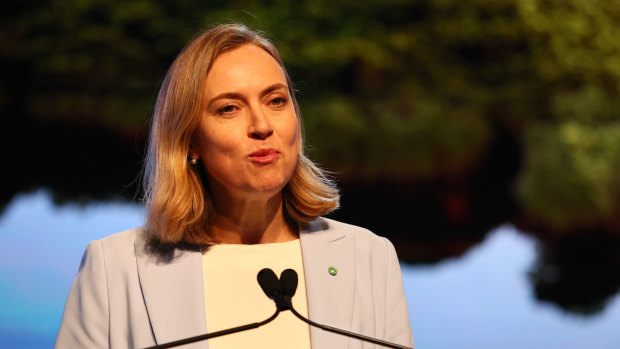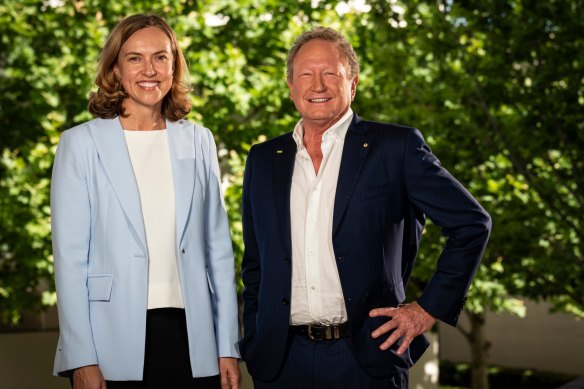This was published 1 year ago
Fortescue suffers $3b wipeout as CEO makes shock exit
By Simon Johanson
Top resources executive Fiona Hick lasted less than six months as chief executive of iron ore magnate Andrew “Twiggy” Forrest’s Fortescue Metals Group before exiting in a shock announcement that has wiped about $3 billion off the miner’s books.
Fortescue said on Monday it had vaulted iron ore operations officer Dino Otranto into the top job. Hick, who was trumpeted as Fortescue’s future boss in a November announcement last year, made a “joint decision” with Fortescue’s board to leave, the company said in a statement.

Fiona Hick began as Fortescue chief executive in February, after succeeding Elizabeth Gaines.Credit: Tertius Pickard
Hick was with Forrest and other senior executives over the weekend at Fortescue’s lavish 20th birthday celebrations in the Pilbara, where Forrest entered the outdoor venue on an enormous tipper truck, waving the company flag to the tune of AC/DC’s Thunderstruck.
Senior executives would not disclose details around the timing or cause of the former Woodside executive’s sudden departure, but it appears her exit was finalised over the weekend. When asked about Hick, Fortescue Future Industries boss Mark Hutchinson told journalists and analysts: “The decision was mutually agreed between her and the board on the 27th of August.”
The surprise reshuffle in Fortescue’s top ranks follows two years of turmoil, as multiple Fortescue executives left the company, including chief financial officer Ian Wells and former Reserve Bank deputy governor Guy Debelle.
Forrest, who is Fortescue’s executive chairman, a major shareholder and the driving force behind the company’s $9.2 billion transition to a fully integrated green technology, energy and metals powerhouse, didn’t attend Monday’s end-of-financial year investor briefing, which left Hutchinson and Otranto to answer questions from media and analysts.
Otranto’s promotion to chief executive of the mining division puts him on the same level as Hutchinson, who runs Fortescue’s clean energy division.
They revealed to investors that over the year Fortescue had record iron ore shipments of 192 million tonnes, net profit of $US5.5 billion ($8.5 billion), and an unexpected $US726 million ($1.1 billion) writedown at its troubled Iron Bridge magnetite operation, which dragged the company’s underlying profit down to $US4.8 billion ($7.4 billion).
Investors reacted to the surprise CEO exit by sending Fortescue’s shares 5 per cent lower to $19.75 in morning trade, which wiped about $3 billion off its value.
“The departure of Fiona has been both friendly and mutual, and we warmly wish her the best for her future,” Fortescue’s board said in statement. Forrest also recognised Hick’s contribution to the company. “We thank Fiona for her valuable efforts since joining Fortescue just under six months ago and wish her all the best with her future pursuits,” he said.
Hick said on LinkedIn that she valued her experience at Fortescue and thanked the company and its people for the opportunity. “I now look forward to time with family and friends while I consider my next move,” she said.
Multiple analysts with top-tier investment banks expressed concern about the instability in the company’s executive ranks. Goldman Sachs analyst Paul Young told Hutchinson and Otranto: “With respect to Fiona’s departure, I hear your explanation, but I do think shareholders deserve a better explanation seeing as she departed with only five months in the role, and also considering the C-suite changes in the past two or three years.”
Robert Stein from CLSA said: “One of the key advantages Fortescue has is operational capability and the ability … to drive cost improvements and productivity. It is a risk that such turnover [in executives] can start to erode that operational discipline.”
Otranto responded: “We’re still inherently very, very low in terms of our overall leadership turnover.”
Otranto said the company has performed strongly despite the executive turnover. “The reporting of executive turnover started 18 months, two years ago, and we haven’t missed a beat,” he said.
Hick, who had proven operational experience in highly complex energy and mining projects at both Woodside and Rio Tinto before being lured to run Fortescue, began in the role in February. She took over from Elizabeth Gaines, who stepped down as chief executive in August last year.
Fortescue is undergoing an ambitious transformation from an iron ore miner to a green hydrogen and clean energy company. The company is on an accelerated pathway to achieve net zero emissions by 2030, spending big on renewables and alternative energy sources.
Fortescue cut its final dividend to $1, taking its full-year dividend to $1.75 per share, which equates to $5.4 billion or a 65 per cent payout of underlying net profit. The company has given guidance of $US800 million ($1.2 billion) in net operating expenditure and $US400 million ($620 million) in capital expenditure for the 2024 financial year, which includes operating expenditure incurred for decarbonisation.

Fiona Hick with Andrew Forrest in November, when she was announced as Fortescue Metals chief executive.Credit: Tony McDonough
The Market Recap newsletter is a wrap of the day’s trading. Get it each weekday afternoon.